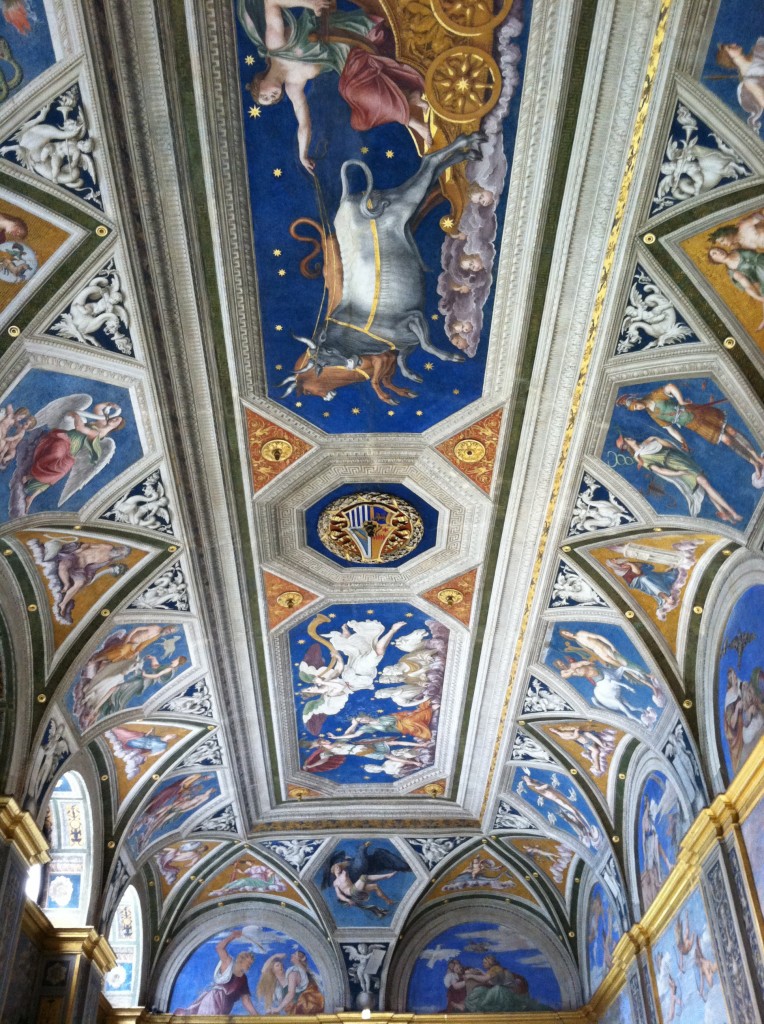
By Patrick Hunt –
In the green Trastevere area of Rome on the Via della Lungara along the Tiber River, the Villa Farnesina is one of the Renaissance jewels of Rome, splendid with art and architecture from its inception between 1506-10. Its name has been associated with the Farnese Family since 1579, but it was originally called by other names by its owner and others. The villa’s owner was the fabulously and financier wealthy Sienese merchant Agostino Chigi (1466-1520), “by far the richest man in Rome”. [1] He commissioned an unknown architect and painter Baldassare Peruzzi (1481-1536) for the villa’s overall design, a Sienese like Chigi. At least during the remainder of Chigi’s lifetime the villa was also called Viridario (from the Latin viridarium as a “Roman pleasure garden”) for its lush Tiber gardens, a few of which can be seen today surrounding the villa. It was also called by contemporaries as “Villa Suburbana” due to its location and was certainly informally also known as the Villa Chigi. My visit to the Villa Farnesina in 2011 was a highlight of an art research week in Rome.
Before the Villa Farnesina, Peruzzi had worked with Bramante, Raphael and Sangallo in various roles but this was his first major architectural project and offered an inverted Vitruvian solution to the space with some Pompeian precedent but reversed with the hortus outside.[2] Inside and especially in the loggias, the Farnesina’s visual art includes fresco work by Raphael and artists associated with him as pupils. Giulio Romano (1499-1546), Raffaellino del Colle (1490-1566), Giovanni da Udine (1487-1564) and Gianfrancesco Penni (c. 1490-1528) all assisted Raphael in carrying out his designs for decorating the interior of the villa, as Vasari relates. [3] Chigi also brought il Sodoma (1477-1549) from his native Siena (where he had already worked in the Palazzo Chigi) to Rome as well as commissioned Sebastiano del Piombo (1485-1547) for additional paintings in the villa.
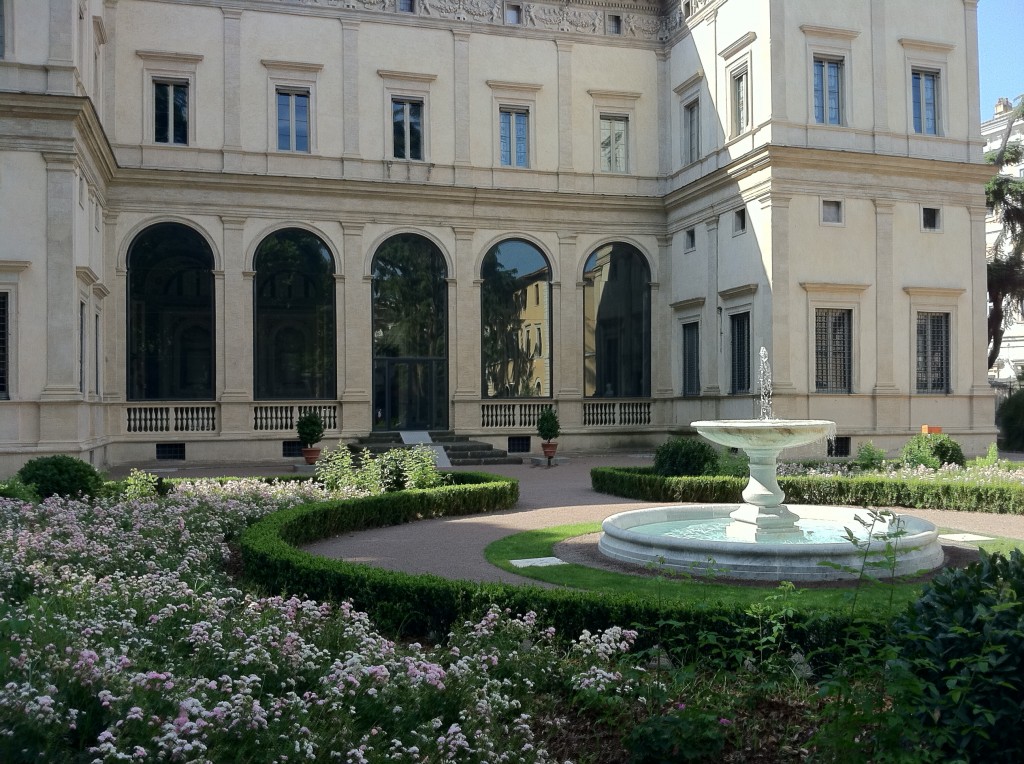
Agostino Chigi wanted only the best and had the means to afford the finest taste in art, thus commissioning the best artists of Rome in their prime. Chigi intended to live in this jewel of a villa with his beautiful Venetian mistress Francesca Ordeaschi. He had met Francesca in 1511 when she was a shopkeeper’s daughter and she eventually bore his four children by 1518. Nonetheless they lived openly in this gem of a villa until they were finally married with Pope Leo X’s blessing in ceremonious style in 1519, the year before his death at age 54. No doubt part of the urgency of marriage so late in his life was to legitimize his inheritance for his wife and children, as Chigi had been a financier to popes and emperors and could seemingly certainly obtain papal blessing whenever he desired. [4] The Psyche connections to Francesca are nonetheless very compelling, since in both the myth of Psyche and in Francesca’s own life, social mores often oppose a girl whose beauty rivals that of Venus in the eyes of mere mortals, with such an elevation as both Psyche and Francesca obtained. Psyche’s case likely suffered through more mythic ordeal than Francesca’s since the Roman Church, no stranger to mistresses, was less jealous than Venus. [5]
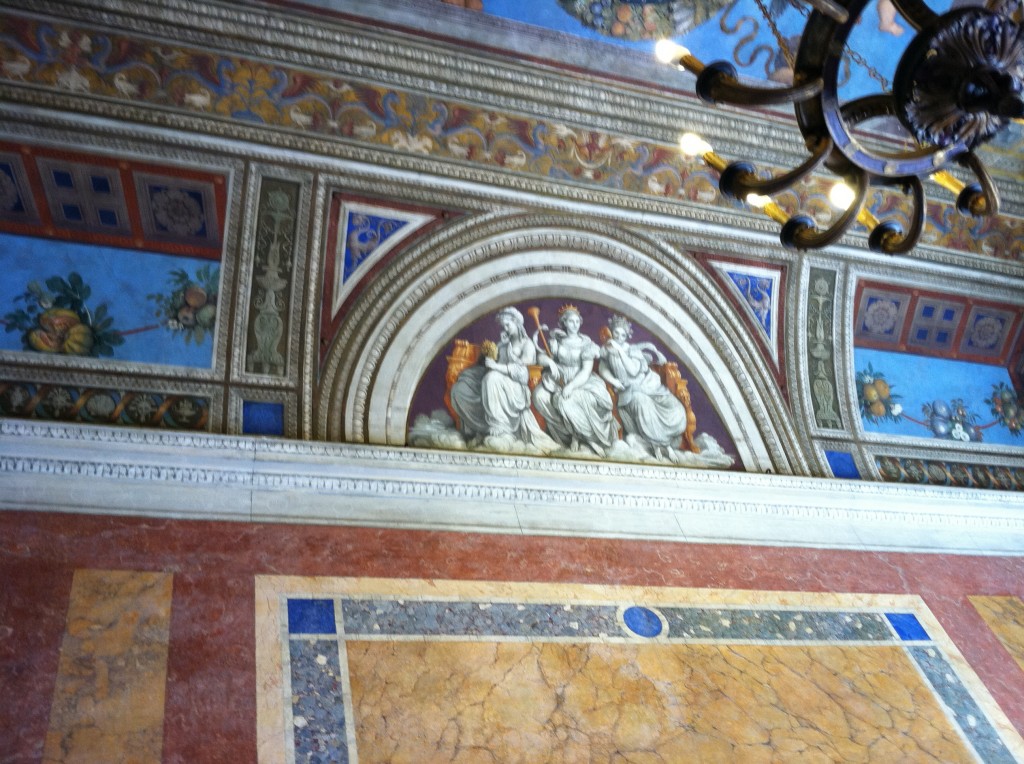
Since Vasari’s ‘Life of Raphael’ it is clear that Raphael designed much of the narrative mythology in the villa at least by 1511, [6] including the Triumph of Galatea and Psyche loggias. The famous myth of Cupid and Psyche is best told by the second century CE Roman writer Lucius Apuleius as an allegorical fable in his Golden Ass (Metamorphoses), a tale that has inspired many later writers from Boccaccio, Machiavelli, Shakespeare and Keats to Jean Cocteau and C.S. Lewis. [7] The fresco of Galatea in the loggia of that name is assumed to be painted by Raphael himself around 1511, one of his few paintings without a religious theme.The Humanist scholar and poet Angelo Poliziano (1454-94), pupil of the Medici Neoplatonist philosopher Marsilio Ficino in Florence and part inspiration for Botticelli’s Primavera and Birth of Venus, is also a Classical literary source for the Galatea myth in his Stanze 118 poem:
“Two shapely dolphins pull a chariot, on it sits Galatea and wields the reins; as they swim they breathe in unison, a more wanton flock circles around them: one spews forth salt waves, others swim in circles…” [8]
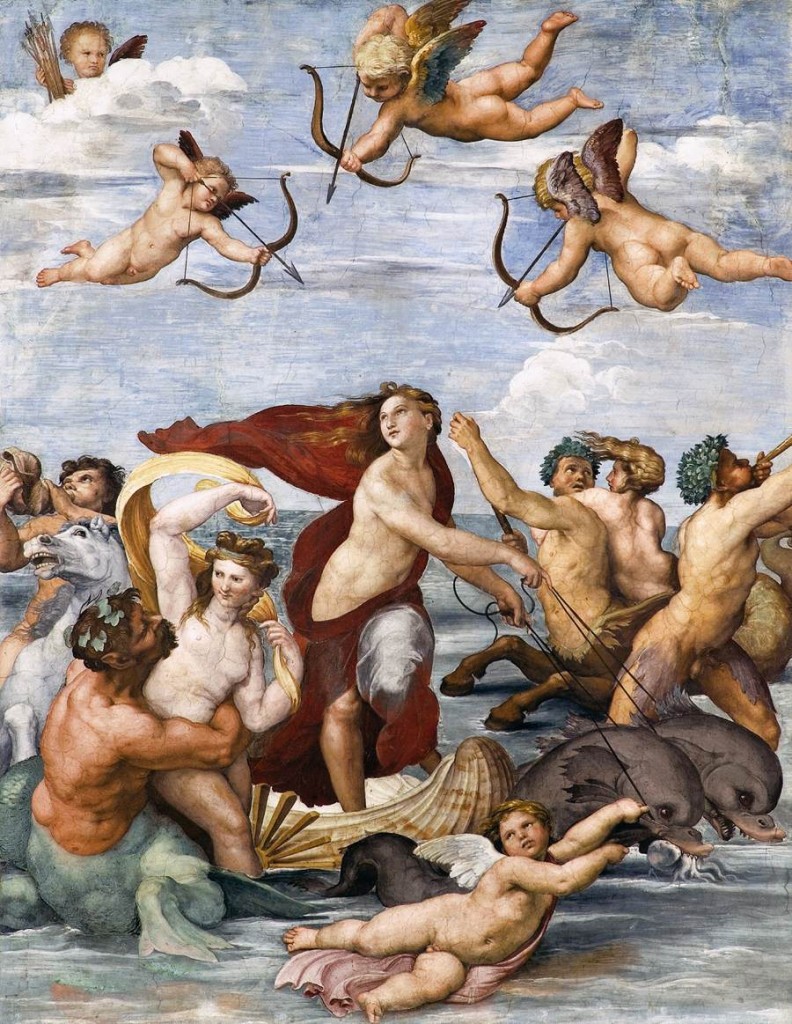
Note the pair of dolphins pulling Galatea’s chariot in Raphael’s painting as an ekphrasis of the Stanze 118 poem. Poliziano is a likely source as well as in his transcriptions and derivations of Apuleius and his Cupid and Psyche fabella for some details of the Chigi visualization of these myths, along with Francesco Colonna’s elusive 1499 allegory Hypnerotomachia Poliphili. [9]
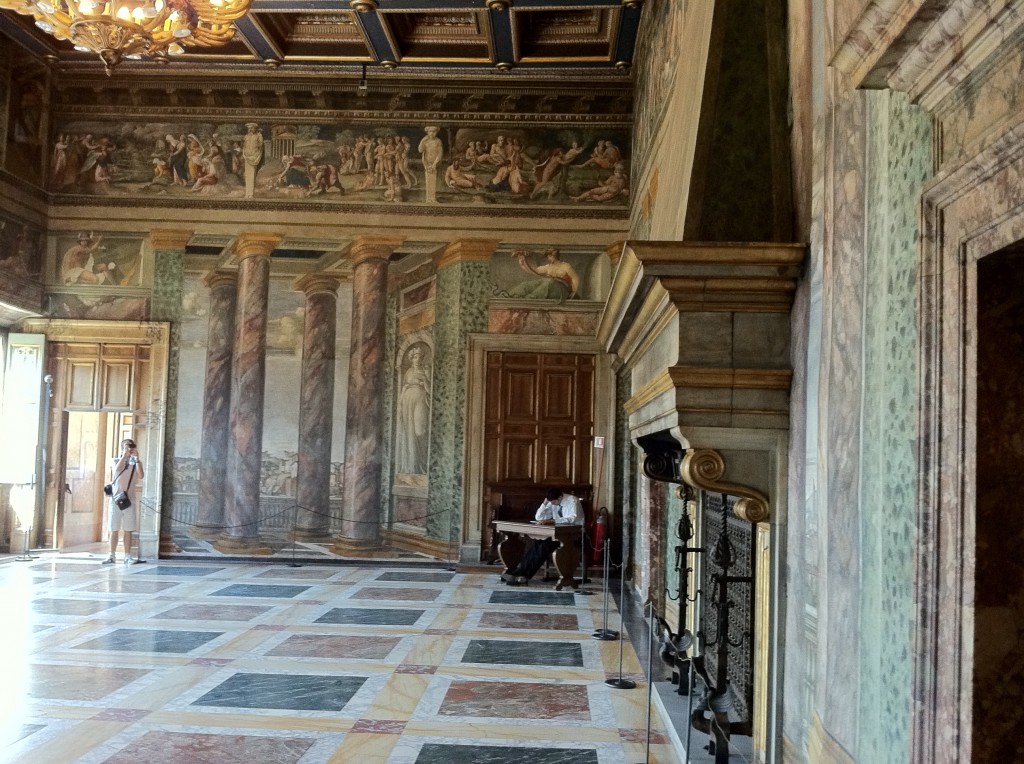
The painted ceilings of the villa’s enclosed ground level loggias and other rooms upstairs are worthy of much study, and their breathtaking depictions of myth and history are unparalleled for the scale and coloration of the Galatea and Cupid and Psyche stories – especially the gods and characters in larger scale in the Psyche Loggia spandrels and the wide use of sky blue in the ceiling frescoes – as well as scenes from the life of Alexander the Great upstairs by il Sodoma. Peruzzi as architect also executed an illusionary trompe-l’oeil colonnaded loggia upstairs with a country landscape visible between painted columns, best viewed from a certain angle on one spot on the floor.
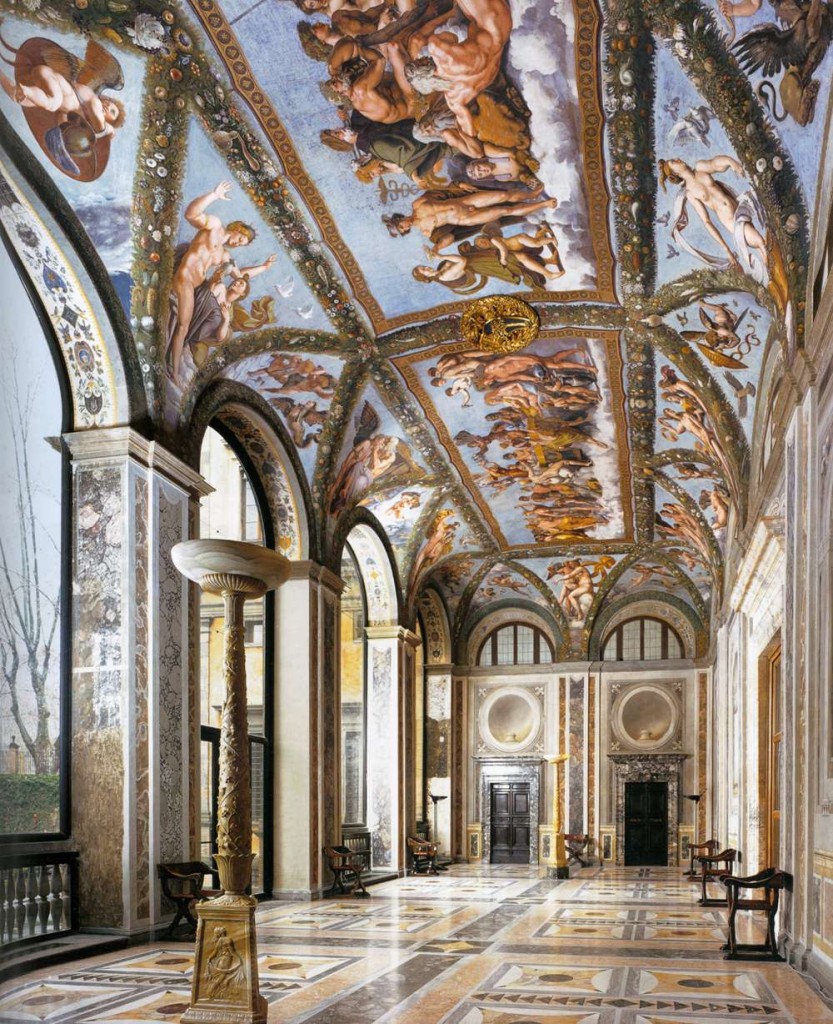
In the Psyche loggia, the frescoed images of the groups of collective gods (center of the vault in two large rectangles) and individual gods and the narrative episodes in the spandrels are in quite different styles, some undertaken by Guilio Romano and others by Raffaellino del Colle and Gianfrancesco Penni but the attributions are often difficult, not least because Vasari is also inexact. Because his work was mostly not connected to the stories being narrated in the Farnesina’s art, however, Giovanni da Udine painted all the lifelike fruitful festoons in the Loggia of Psyche, some with obvious erotic connotations in his conjoined gourd (or cucumber) and fig (also note Italian wordplay) in the Mercury spandrel fresco mostly attributed to Giulio Romano. The Psyche Carried by Amorini spandrel (notable for its perspective from below), the Venus, Ceres and Juno spandrel and the Cupid and the Three Graces spandrels, all usually attributed to Giulio Romano following Raphael’s designs, are among the most majestic and well-executed of the Farnesina frescoes.
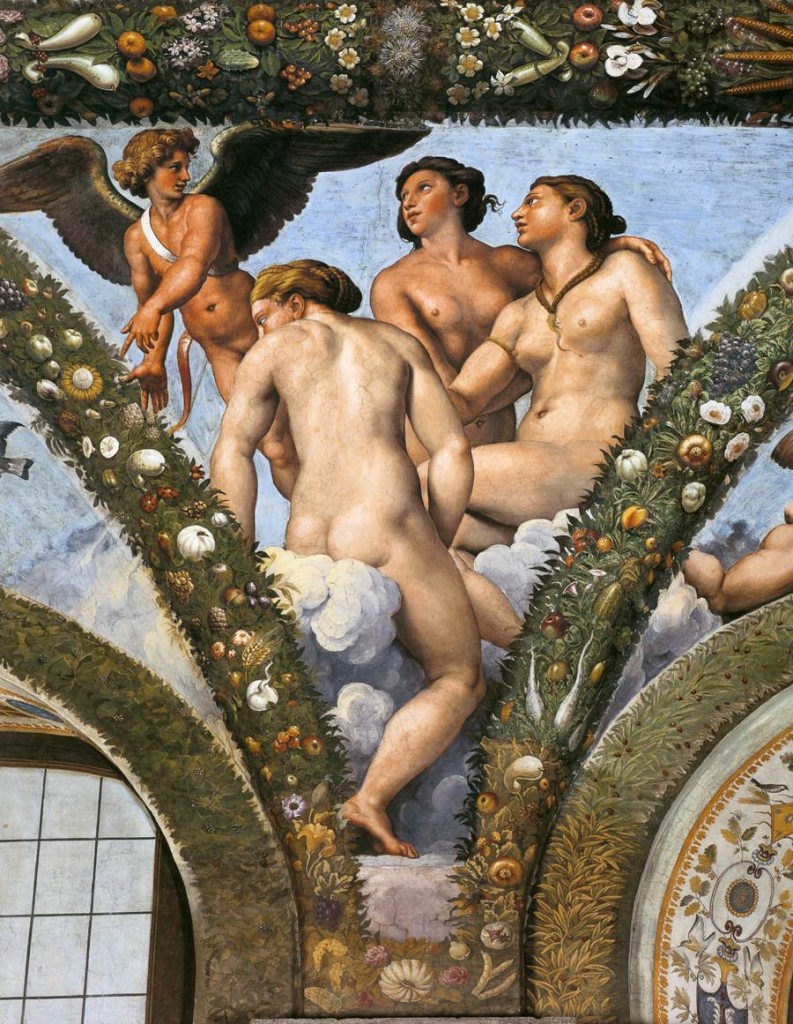
The Three Graces seated in the clouds listen as young Cupid relates the story of Psyche and his mother Venus’ initial opposition – jealous of Psyche’s beauty – to mortal Psyche as his lover and eventual wife, as Apuleius originally tells it in Book Six of his 2nd c. The Golden Ass. Below, as the narrative relates of her ordeals commanded by Venus, Psyche is taken to Venus carrying the vessel she thinks holds Proserpina’s beauty but actually holds deadly “Sleep of the Innermost Darkness, the night of Styx”. Psyche opens the box desiring to be beautiful for Cupid and restored to him. In doing so, disobeying Venus, she swoons toward death, needing to be revived by Cupid. Whether the repeated face of Psyche in any way resembles that of Francesca Ordeaschi through the various artists is an unanswered question, but would be apropos for Agostino Chigi’s villa, however unlikely Psyche’s visage is in any more emphatic fashion other than as a narrative crux for the overall story. The Cupid and Psyche myth corpus has often been cited as a Classical allegory for the ascent of the soul as well as the elevation of the soul to immortality through love (especially love of beauty), based in some way on Socratic philosophy in the Symposium through Diotima’s “ladder of love” as well as in the Platonic Phaedrus 239 & ff. [10] In Apuleius’ Cupid and Psyche fabella, Mercury even carries Psyche to heaven and the marriage banquet, just as in the Farnesina frescoes. In Apuleius, Jupiter also legislates – similar to Pope Leo X with Agostino Chigi’s union with Francesca – that “the marriage is not a misalliance but perfectly in accord with usage and the civil code.” [11] The Classical Cupid and Psyche narrative used by Apuleius is also emblematic as is Eros in Greek: “Cupid is both a force that leads a soul to heaven and the boy with the bow and arrows” in the story. [12] Apuleius’ Golden Ass – one of the first authors printed in Italy according to Lindsay [13] – was readily available to Renaissance readers as early as 1469 edited by Giovanni Andrea de Bussi.
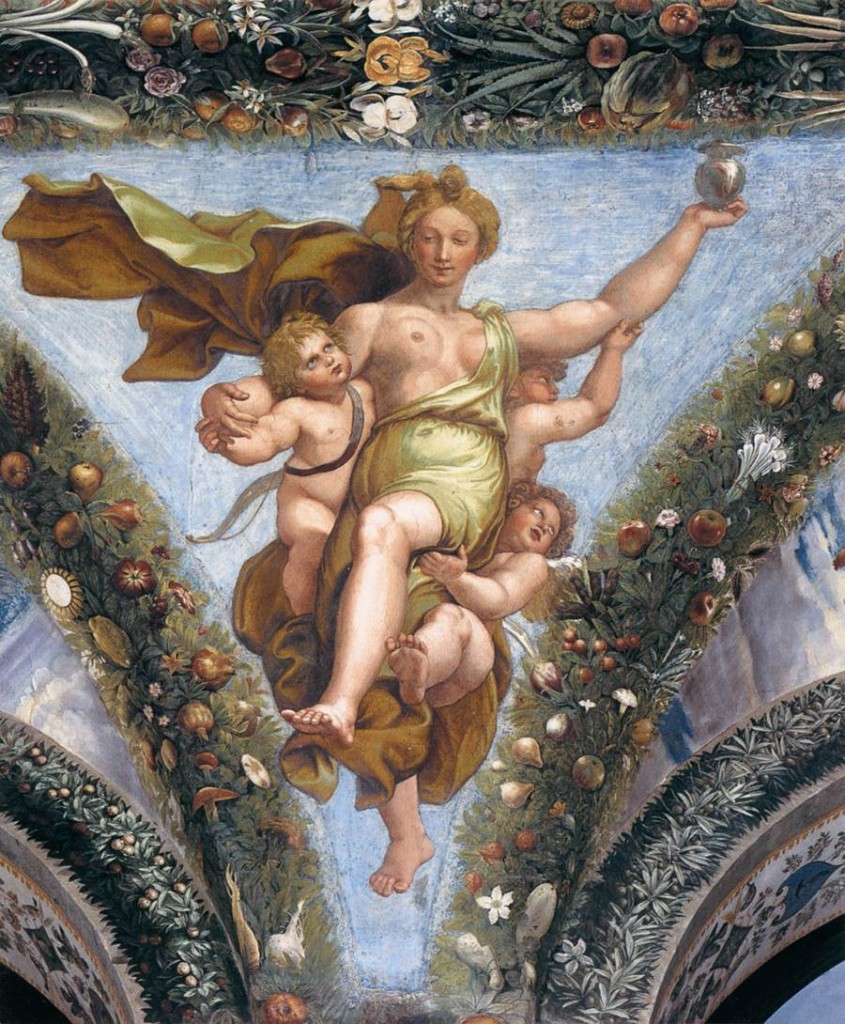
The exquisite marbles Chigi purchased (seen, for example, in the floors in several above photos) were commented on from the outset in the early 16th century, as Rowland quotes; “It is wondrous how many marbles he gathers together and precious ones at that…” [14] Despite these amenities and other luxuries in the villa, including the best decoration available by consummate artists, the villa itself was not ostentatious in size but very restrained relative to other Renaissance palazzi of the day, even some close by in Rome. Its location at the very base of the Janiculum hill – seen through the villa’s upper western windows – may have also been important to Chigi as the southernmost promontory of supposed Etruscan (Tuscan) domains.[15] The Chigi Villa in its “Viridario” garden setting was one of the many acquisitions of the rising Farnese Family in 1577 and its name changed to the Villa Farnesina in 1579. Outside in the Villa Farnesina’s once “spectacular” Tiber gardens, [16] but now greatly reduced, still give a sense of how beautiful the setting was designed to be for Agostino Chigi and Francesca Ordeaschi as their Viridario. In my photo below, the current Farnesina parterre gardens on the south side stop just at this side of the hedge at the bottom, but presumably the original Viridiario gardens extended to the far tree line by the Tiber River. Even if Agostino Chigi’s and Francesca Ordeaschi’s life together was hardly a decade, the legacy of the Villa Chigi-now- Farnesina is a Renaissance testimony to love and superb taste when resources knew no obstacle, perhaps like the Cupid and Psyche fable itself with a theme of Amor omnia vincit, “Love conquers all.” [17]
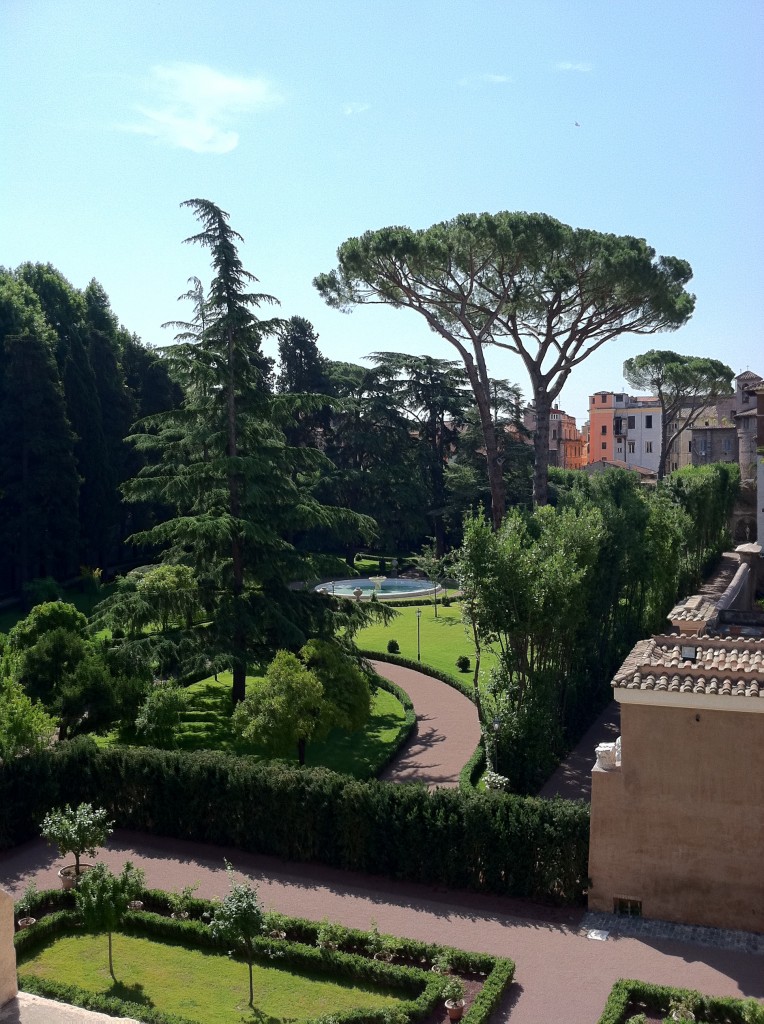
Notes:
[1] Ingrid D. Rowland. “Render unto Caesar the Things Which Are Caesar’s: Humanism and the Arts in the Patronage of Agostino Chigi.” Renaissance Quarterly 39.4 (Winter 1986) 673-730.
[2] ibid., 684
[3] Giorgio Vasari. Lives of the Artists. Florence (1568). Julia Conaway Bondanella and Peter Bondanella, tr. Oxford University Press, 2008 ed. Relative to Raphael whom he enshrines, deigning him a “mortal god”, Vasari is not always complimentary of lesser-known artists like Raphael’s pupils, including Gianfrancesco Penni and il Sodoma (Giovanni Bazzi) and even Giulio Romano. For example, see Raphael as a “mortal god” (p. 306) versus il Sodoma unappreciated by Pope Julius II (p. 314) with his work ordered to be torn down by the pope’s order.
[4] As Rowland notes (p. 680), “the relationship between pope and merchant became one of unusual closeness…” On the other hand, being a mistress to an unmarried wealthy man was perfectly acceptable until inheritance became important legally. Also see Roderick Conway Morris. “Sebastiano del Piombo: Giving a masterful portraitist his due.” Review of the Exhibition “Sebastian del Piombo, 1485-1547” at Palazzo Venezia, Rome. New York Times, March 14, 2008. Morris also suggests that Sebastiano del Piombo’s Gemäldegalerie (Berlin) painting “Portrait of a Young Woman” ca 1512-13 is a likely portrait of Chigi’s then mistress Francesca Ordeaschi. Rowland also suggests Chigi’s largesse to Leo X : “Leo’s very election may well have been facilitated by loans from Agostino Chigi…” p. 712.
[5] This author is not alone in making this connection, indeed many have suggested the same: e.g., see the beautifully illustrated and well-written art blog “The Pines of Rome” by Tiffany Parks: http://thepinesofrome.blogspot.com/2012/03/story-of-cupid-and-psyche-continues-in.html
[6] Michele Rak. “From Word to Image: Notes on the Reception of Apuleius’ Work”, in Marilia P. Futre Pinheiro and Steven J. Harrison, eds, Fictional Traces: Receptions of the Ancient Novel, Ancient Narrative Supplementum, 14.1 & 2, Vol. 2, 2011, 83-94 & Appendix, 2.
[7] Jack Lindsay, tr. The Golden Ass of Apuleius. Bloomington: Indiana University Press, 1962 ed., 27-8.
[8] David Quint, tr. The Stanze of Angelo Poliziano. Pennyslvania State University Press, 1993, 60-61. “Due formosi delfini un carro tirono: sovresso è Galatea che ‘l fren correge, e quei notando parimente spirono; ruotasi attorno piú lasciva gregge: qual le salse onde sputa, e quai s’aggirono…”
[9] Christopher Celenza. Angelo Poliziano’s Lamia: Texts, translations and Introductory Studies. 2010, 18, regarding fibula/fabella : “Apuleius is one of his [Poliziano] favorite authors”(although here Celenza is mainly referring to Apuleius’ Florida).
[10] also long seen in Jean La Fontaine’s 17th c. version of Cupid and Psyche, Les Amours de Psyché et de Cupidon, c.f. Nathan Gross. “Functions of the Framework in La Fontaine’s Psyché.” PMLA [Journal of the Modern Language Association] 84.3 (1969) 577-86; also see A. van de Vijver. A Comparison of Plato’s Views of Eros in the Symposium and Phaedrus. M.A. Thesis. University of South Africa, 2009, esp. p. 26: (Groag: “it is Eros that gives Psyche her wings”) [speaking of the soul, not the myth character] & p. 45 ff; also see R. Schusterman. “Soma and Psyche.” Journal of Speculative Philosophy 24.3 (2010) 205-23.
[11] in Lindsay’s translation, 141.
[12] Joel C. Relihan., tr. Apuleius, The Golden Ass. Cambridge: Hackett Publishing, 2007, xxiii.
[13] Lindsay, 24
[14] Rowland, 690
[15] Rowland, 718-20, especially since Annio da Viterbo (Giovanni Nanni) claimed Etruscan connections to Rome on the Janiculum Hill.
[16] ibid., 684
[17] Amor omnia vincit is variously rendered in Latin with flexible syntax / word order, but is certainly a theme of Apuleius’ telling of the Cupid and Psyche myth.